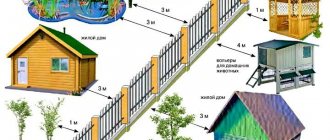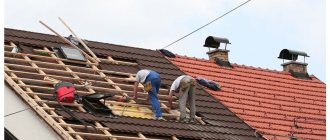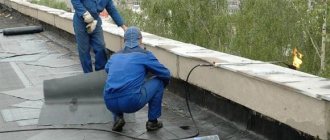The line of responsibility between the owner and the management company is established by legislation in the housing and communal services sector and is specified in the management agreement for an apartment building. Understanding where the responsibility of the owner ends and the responsibility of the management organization begins is important, because public utilities rarely unconditionally admit their guilt in the event of accidents and other incidents. It also happens that the owners and tenants of premises themselves become the cause of their own troubles, since they do not repair the property in their area of responsibility, mistakenly considering it to be common property. Our article will help you avoid this kind of trouble.
Area of responsibility for water supply
The area of responsibility of the water supply management company is determined:
- Housing Code of the Russian Federation;
- rules for maintaining common property in an apartment building, approved by Decree of the Government of the Russian Federation dated August 13, 2006 No. 491 (hereinafter referred to as the Rules for maintaining common property);
- rules for the provision of utility services to owners and users of premises in apartment buildings and residential buildings, approved by Decree of the Government of the Russian Federation dated May 6, 2011 No. 354 (hereinafter referred to as the Rules for the provision of utility services).
Provisions sub. 3 p. 1 art. 36 and art. 161 of the Housing Code of the Russian Federation, clause 5 of the Rules for the maintenance of common property oblige the management organization to maintain in good condition the in-house hot and cold water supply systems up to the first disconnecting device and this device itself.
Thus, the Vasileostrovsky District Court of St. Petersburg filed a claim against the management organization of the owner of an apartment that was flooded with water due to an accident in the cold water supply riser that occurred on the technical floor. The court found the claims to be justified and partially satisfied the claim, collecting from the defendant an amount of compensation that was less than what the plaintiff requested. The St. Petersburg City Court upheld the plaintiff’s appeal and, by ruling dated September 4, 2018 in case No. 33-11105/2018, increased the amounts recovered from the defendant.
According to sub. “a” clause 31 of the Rules for the Provision of Public Utilities, a company that manages an apartment building on the basis of agreements with the owners is responsible for the quality of water supply and other housing and communal services.
Payment
Actions aimed at collecting additional funds from residents for the repair of risers are considered illegal . After all, repair work is already carried out from the funds of apartment owners.
ATTENTION! Payment of utility bills includes the column “maintenance and repair of housing.” The size of the amount is affected by the square footage of the premises and the number of residents.
According to the standards of MDK 2-04.2004, the list of services included in the rent includes:
- emergency work;
- maintenance of common property;
- Maintenance;
- communications maintenance.
Consequently, replacing the riser in an apartment is free of charge, since payment has already been made. In cases where a major replacement of risers on each floor is required, funds are taken from payments for major repairs.
However, there are exceptions when the owner of the apartment, at his own request, has made structural changes, resulting in the need for repairs. All costs for replacing the riser in this case are borne by the owner; the work is carried out by him independently. If neighbors also suffered damage, they also need to be compensated for the damage.
Responsibility of the management company to the owners for common property
In addition to the water supply system, management organizations, by virtue of paragraph 2 and paragraphs. 5–7 Rules for the maintenance of common property are responsible for the good condition of common property, which includes:
- Common areas.
- Roofs.
- Enclosing load-bearing and non-load-bearing structures of an apartment building.
- The adjacent territory with elements of landscaping and landscaping within the boundaries determined according to the cadastral data of Rosreestr.
- Automated information and measurement systems for accounting for the consumption of utility resources and services, which were installed at the expense of apartment owners.
- Other facilities serving the house:
- transformer substations and heating points serving one house;
- collective parking lots;
- garages;
- children's and sports grounds.
- Mechanical, electrical, sanitary and other equipment serving more than one premises, as well as equipment that provides access to a residential building for disabled people and other categories of the population with limited mobility. Including:
- in-house engineering drainage system - up to the first butt joints;
- in-house engineering gas supply system - up to the shut-off valve and this valve itself;
- in-house power supply system - up to individual electrical energy metering devices;
- in-house heating system.
Within the meaning of clause 6 in conjunction with sub-clause. “d” clause 2 and clause 5 of the Rules for the maintenance of common property, utility workers are responsible for the condition of only those heating elements of the heating system that are located outside the apartments (on stairwells, in basements, etc.). A radiator with a shut-off device, located on a branch from the riser of the intra-house heating system in an apartment, is not common property, since it serves only one room. Moreover, according to Art. 26 of the residential complex, it can be dismantled after obtaining permission to renovate the residential premises (appeal ruling of the Voronezh Regional Court dated September 18, 2018 in case No. 33-5707/2018).
Operating conditions for water pipelines
Operating conditions will have the greatest influence on the choice of pipes for water supply: we will have to select their technical characteristics depending on the maximum temperature and pressure in the water supply. In each of the three scenarios, these conditions will differ markedly.
HVS
With cold water supply, regardless of its source, the water temperature changes slightly throughout the year:
- In winter it drops to 8-10 degrees;
- In summer, the water in the pipes can warm up to 15-20°C.
Cold water temperature varies slightly throughout the year
The pressure in the cold water system is quite stable and usually ranges from 1.5 to 4.5 kgf/cm2. Water hammer is extremely unlikely: the cold water supply system is a dead end, without circulation, so when it is quickly filled, the air in the pipes will act as a damper and prevent a pressure surge.
Typical Cold Water System Pressure
Autonomous DHW supply
The heat source in such a system can be instantaneous or storage electric water heaters, gas water heaters and flow-through heat exchangers of double-circuit boilers, as well as indirect heating boilers connected to single-circuit boilers of any type.
For any heating method, two conditions are met:
- The water temperature is completely controlled by the owner. Simply because absolutely any modern heating equipment is equipped with thermostats;
- The pressure in the DHW system is exactly equal to the pressure in the cold water supply system. Water hammers are again impossible in principle.
Autonomous hot water supply: pressure equal to the pressure in the cold water system
Centralized hot water supply
It is implemented by directly supplying the consumer with technical hot water from the supply or return lines of the heating main. Water is supplied through inserts into the elevator unit between the inlet valves or taps on one side and the water jet elevator on the other. In extreme cold, when the supply water temperature exceeds 75 - 80 degrees, the hot water supply is manually switched to return; at other times it is supplied from the supply.
Elevator unit with hot water supply connections
Graph of supply and return temperatures of the heating main depending on weather conditions
Standard DHW parameters in a house with centralized hot water supply must fall within the following boundaries:
| Parameter | Meaning |
| Temperature | 60 - 75°С |
| Pressure | 3 - 7 kgf/cm2 |
However, there are a number of force majeure situations in which these values can be greatly exceeded.
An instant stop in the circulation of water in a heating main or a hot water supply system with recirculation (due to a quickly closed ball valve or a malfunction of the valve - falling of its cheeks) will lead to water hammer. For a split second, the pressure at the flow front can increase to 30-40 atmospheres;
Stopping circulation in a closed loop leads to water hammer
If a forgetful mechanic does not switch the hot water supply from supply to return when it gets cold, water with a temperature above the boiling point will continue to flow into the water supply (up to a maximum of +150°C);
When pressure drops, superheated water instantly boils
In the spring, heating mains and heating systems undergo temperature tests: the coolant is heated to the maximum values stipulated by the temperature schedule. Hot water supply must be turned off during testing. If for some reason (human factor, failure of shut-off valves) is not done on time, overheated water will again flow into the hot water system.
Responsibility of public utilities for improper provision of services
Responsibility of management companies for improper provision of services is of three types:
- Administrative. It threatens companies that, while managing the housing stock on the basis of a contract and license, do not comply with the requirements for the quality of public services provided or the maintenance of common property. Their actions are qualified under Part 2 of Art. 14.1.3 of the Code of Administrative Offenses of the Russian Federation. For an official, for example a director of a company, punishment under this article provides for a fine of 50 to 100 thousand rubles. or up to 3 years of disqualification. For a legal entity - a fine of 250 to 300 thousand rubles.
- Civil law. Occurs, in accordance with the provisions of the Civil Code of the Russian Federation, for the management organization, through whose fault physical, property or moral harm was caused to consumers of utility services. In this case, upon the claim of the injured party, the court may recover a decent amount of money from the culprit.
- Criminal. Provided by Art. 238 of the Criminal Code of the Russian Federation. Under this article, guilty officials are held accountable if poor-quality housing and communal services have resulted in harm to the health or death of citizens.
Types of materials for riser
There are requirements that relate to the service life of pipe products made from different materials. They are listed in SP 30.13330.2012. This document clearly states that pipes installed in the hot water supply system must last at least 25 years. In a cold water supply system - at least 50 years.
Previously used steel products lasted much less. Departmental building codes provide data on each type of pipe in terms of their long-term operation.
| Pipe type | Service life in a cold water supply system, years | Service life in hot water supply system, years |
| Steel gas pipeline | 15 | 10 |
| Galvanized | 30 | 20 |
Practice shows that steel pipes in cold water supply systems serve much less than the stated period. The reason is condensation that forms on the outer surface. It is a catalyst for the corrosion process of metals.
Today, risers are increasingly being built from plastic pipes. But when choosing the latter, it is necessary to take into account their strength characteristics. For cold water supply, you can use polypropylene pipes of PN10 grade, for hot water, at least PN20. Metal-plastic models can be used without restrictions.
Materials
What materials do trading companies suggest for installing water supply and sewerage systems?
Here is a list of the most popular solutions:
| Image | Description |
Galvanized water pipe with threads | Galvanized steel pipe (like black steel, it is produced in accordance with GOST 3262-75). Galvanization differs from polymer pipes in durability, but is difficult to install: water pipes are assembled only on threads, because the zinc coating burns out during welding. |
Copper water distribution on solder fittings | The copper pipe is assembled into the water supply using compression, press fittings or solder joints. The advantage of the material is an almost unlimited service life, the disadvantage is its high cost (300 or more rubles per linear meter). |
Corrugated cold water and hot water supply lines | Corrugated stainless steel also boasts an unlimited service life; at the same time, it costs half as much as copper and is much easier to install on compression fittings tightened with a pair of adjustable wrenches. Disadvantages: the service life of silicone fitting seals is limited to 30 years and large pressure losses due to the specific shape of the pipeline walls. |
Polypropylene - with and without reinforcement | Polypropylene pressure pipe compares favorably with its competitors due to its low cost (from 20 rubles per meter). The material is mounted on equally inexpensive (from 3-5 rubles) fittings for socket welding. For hot water supply, it is customary to use pipes reinforced with fiber or foil: they are more tensile and elongate less when heated. |
Water distribution with PEX pipes | Cross-linked and heat-resistant polyethylene (PEX and PERT) are used primarily for hidden collector water distribution. Despite the relatedness, the materials differ in installation methods: PEX uses mainly fittings with sliding sleeves, while PERT uses socket welding fittings. |
From top to bottom - press, push and compression fittings on metal-plastic | Metal-plastic water pipes have internal and external shells made of the same modified polyethylene, but an aluminum core that increases tensile strength is glued between them. To install connections, push, press and compression fittings are used. |
Cast iron pipes | Cast iron sewer pipes and fittings have now been practically replaced by plastic, and deservedly so. It is expensive, heavy and inconvenient to install: the joints are hammered with hemp (tarred hemp) and sealed with cement. |
PVC sewer pipes | PVC sewerage, on the contrary, can please the buyer with a modest price tag, extremely simple cutting and easy installation using socket joints with rubber rings. The only drawback of plastic sewerage is noise: a PVC riser will force you to be aware of your neighbors’ toilet visiting schedule. |
Pipes and fittings for sewerage made of polypropylene | A polypropylene pipe differs from a polyvinyl chloride pipe only in slightly greater heat resistance (95 degrees versus 80). |
Silent sewage system produced by Rehau
What does it consist of?
The sewer riser is a structure consisting of several elements. Regardless of whether it is located in a private or apartment building, it contains the following parts:
- main vertical pipe - relatively recently, only cast iron pipes were used for its formation, however, modern systems are created using high-quality and reliable plastic pipes. They are characterized by high strength and low weight. Therefore, even independent installation of such a pipe will not cause difficulties for the owner of a residential premises;
- crosspiece intended for subsequent installation of the toilet. It is mounted at the very bottom of the structure, and one of the very first. Below it it is not allowed to install any pipelines or other elements of the sewer system. If you do this, then during the process of flushing water from the toilet, the hydraulic valves will fail;
- compensator - used for a sewer riser when a transition is made from one type of pipe to another. Most often you have to deal with the fact that an old apartment has a cast iron riser, and its replacement is carried out using plastic pipes. Therefore, without a compensator it will not be possible to complete the work, since otherwise an unreliable and short-lived connection will be obtained;
- revision - represented by a small section of pipe with an optimal diameter. There is a hatch on it, and it can be easily unscrewed if the need arises. This process is usually carried out when the sewer system is clogged. Often people who carry out installation with their own hands without work experience forget about the inspection, so even during the operation of the system, if blockages occur, they have to destroy the integrity of the riser;
- tee - used if only one sink and bathtub are connected to the drain, and if there are additional plumbing fixtures in the apartment or house, then a tee is used to increase the number of outlets. Its diameter cannot be less than 10 cm.
Difficulties may arise in the process of determining the optimal diameter of the riser, and during this process it is taken into account that if there is a toilet in the apartment, then the diameter of its outlet cannot be less than 10 cm, and if there is no toilet, then it is allowed to choose a pipe with a diameter of 5 cm.
Plastic pipes
The plastic heating riser causes mistrust among many. It seems to us that plastic cannot withstand high temperatures and cannot cope with the pressure in the urban system, but this is not at all true. Among pipelines made of polymer materials, two are suitable for installation of heating systems:
- Metal-plastic,
- Polypropylene.
The metal-plastic riser can withstand sufficient temperature and pressure, it does not require mandatory fastening to the wall, and connections using fittings are reliable. However, with temperature changes there is still a possibility of loose connections, so they need to be checked periodically.
Polypropylene material allows parts of the pipeline to be welded, so it does not have the disadvantages of metal-plastic. Reinforced polypropylene, which is used for the installation of heating systems, is able to withstand the temperatures and pressures of even urban heating networks, however, this material is deformed when heated. Deformation involves bending of the pipe. If left unattended, the seal may be compromised, meaning there is a risk of leakage. To avoid negative consequences, polypropylene risers are attached to the wall. This should be done not with clips, but with reliable clamps.
If we take into account the disadvantages of polymer pipes, they will be able to last as long as steel ones: at least 50 years.







